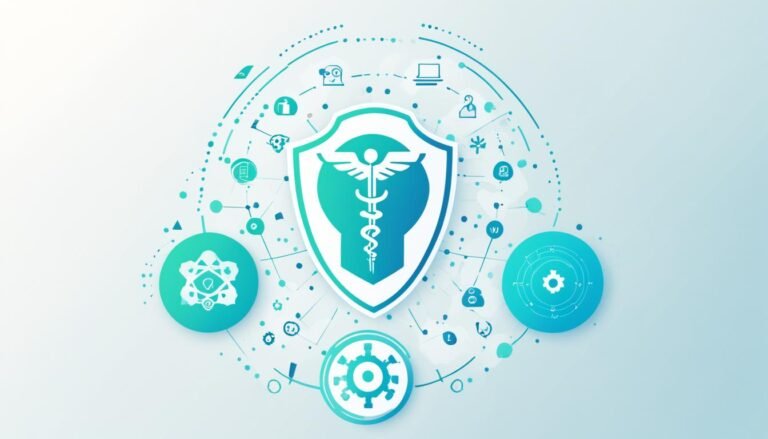Ensuring Privacy and Security in Telehealth Interactions
With the rapid growth of telehealth, ensuring privacy and security in telehealth interactions has become a critical concern. According to a recent study, 70% of healthcare organizations reported experiencing a security breach in the past year. This alarming statistic underscores the urgent need for healthcare providers to implement robust privacy and security measures in telehealth.
In this article, we will explore the importance of HIPAA compliance, secure communication channels, data protection, and cybersecurity mitigation strategies to safeguard patient information and build trust in telehealth interactions.
Key Takeaways
- Potential risks of unauthorized access to patient information
- Importance of adhering to HIPAA requirements in telehealth
- Significance of patient privacy and data protection in telehealth
- Benefits of secure communication channels in telehealth
Understanding the Importance of Privacy and Security in Telehealth
Highlighting the significance of privacy and security in telehealth, it is crucial to understand the potential risks and the need for safeguarding patient information. Privacy regulations and telemedicine ethics play a vital role in maintaining the confidentiality and integrity of patient data in telehealth interactions.
Telehealth, the provision of healthcare services remotely using technology, has become increasingly popular due to its convenience and accessibility. However, the digital nature of telehealth raises concerns about the privacy and security of patient information. Unauthorized access to sensitive medical records can lead to identity theft, fraud, or other malicious activities.
To address these concerns, privacy regulations have been established to protect patient data in telehealth. These regulations, such as the Health Insurance Portability and Accountability Act (HIPAA), set standards for the collection, storage, and transmission of patient information. Compliance with these regulations ensures that healthcare providers handle patient data responsibly, preventing unauthorized disclosure or misuse.
In addition to privacy regulations, adhering to telemedicine ethics is essential in maintaining patient trust and confidence in telehealth services. Ethical considerations, such as informed consent, confidentiality, and the duty to protect patient privacy, guide healthcare professionals in their telehealth practices. By following ethical guidelines, healthcare providers demonstrate their commitment to patient welfare and ensure that patient information remains confidential and secure.
HIPAA Compliance and Telehealth: What You Need to Know
HIPAA compliance is crucial in telehealth to protect patient data and ensure privacy and security. Telehealth providers must adhere to the requirements set forth by HIPAA to safeguard patient information during telehealth interactions.
This includes implementing secure communication channels, encryption protocols, and access controls to prevent unauthorized access or disclosure of sensitive data.
HIPAA Requirements for Telehealth
Maintaining patient confidentiality and data protection are essential considerations when implementing telehealth services in accordance with regulatory standards. HIPAA requirements play a crucial role in ensuring telehealth privacy regulations are met. However, there are several challenges that healthcare providers may face when it comes to HIPAA compliance and telehealth:
-
Lack of standardized telehealth platforms: The absence of standardized telehealth platforms can make it difficult to ensure HIPAA compliance across different systems.
-
Technology limitations: Implementing secure communication tools and encryption methods can be challenging due to technological limitations of telehealth platforms.
These challenges highlight the importance of addressing HIPAA compliance effectively in telehealth settings. Healthcare organizations must navigate these obstacles to guarantee patient privacy and maintain data protection in telehealth interactions.
Protecting Patient Data
Ensuring patient privacy and safeguarding sensitive information are crucial considerations in telehealth, and healthcare providers must adhere to HIPAA compliance guidelines to protect patient data. HIPAA, or the Health Insurance Portability and Accountability Act, sets standards for protecting sensitive patient data and requires healthcare providers to implement safeguards to ensure data confidentiality.
One of the key aspects of protecting patient data in telehealth is securing telehealth platforms. Healthcare providers must choose platforms that have robust security measures in place, such as encryption and secure authentication protocols, to prevent unauthorized access to patient information. Additionally, regular security audits and vulnerability assessments should be conducted to identify and address any potential weaknesses in the system.
To illustrate the importance of securing telehealth platforms, consider the following table:
| Platform Security Measures | Description |
|---|---|
| Encryption | Ensures that data transmitted between the patient and healthcare provider is protected from interception and unauthorized access. |
| Secure Authentication | Requires users to provide valid credentials to access the platform, preventing unauthorized individuals from gaining access to patient data. |
| Regular Audits | Conducting periodic security audits helps identify vulnerabilities and ensure that the platform is up to date with the latest security standards. |
Implementing Secure Communication Channels for Telehealth
Regularly implementing secure communication channels is essential for maintaining privacy and security in telehealth interactions. Telehealth relies heavily on secure video conferencing and secure messaging platforms to facilitate remote consultations and ensure the confidentiality of patient information.
Implementing secure communication channels in telehealth offers several benefits, including:
- Enhanced patient trust: When patients know that their personal health information is being transmitted through secure channels, they are more likely to feel confident in sharing sensitive medical data with healthcare providers.
- Reduced risk of data breaches: Secure communication channels employ encryption techniques, making it significantly more difficult for unauthorized individuals to intercept and access patient data.
- Compliance with privacy regulations: By using secure communication channels, healthcare organizations can demonstrate compliance with privacy regulations like HIPAA, GDPR, and HITECH, protecting themselves from legal consequences and potential fines.
To achieve secure communication in telehealth, healthcare providers should ensure that the platforms they use have robust security measures in place, such as end-to-end encryption, multi-factor authentication, and secure data storage. Regular audits and updates should also be conducted to address any vulnerabilities and ensure ongoing security. By prioritizing secure communication channels, healthcare providers can uphold patient privacy and ensure the integrity of telehealth interactions.
Protecting Patient Data: Best Practices for Telehealth Providers
Protecting patient data is of utmost importance for telehealth providers. Two key practices to achieve this are encryption and authentication.
Encryption ensures that the data transmitted during telehealth interactions is secure and cannot be accessed by unauthorized individuals. Telehealth providers should implement strong encryption algorithms and protocols to safeguard patient data.
Authentication methods such as two-factor authentication can verify the identity of individuals accessing patient data, adding an extra layer of protection.
Encryption for Data Protection
To enhance the privacy and security of telehealth interactions, telehealth providers should implement encryption protocols for protecting patient data. Encryption is a crucial tool in data breach prevention and plays a vital role in ensuring the confidentiality and integrity of sensitive information. By encrypting patient data, telehealth providers can prevent unauthorized access and safeguard against potential cyber threats.
Implementing encryption protocols offers several benefits for telehealth providers:
-
Enhanced Confidentiality: Encryption ensures that patient data remains confidential, even if intercepted by unauthorized individuals. This instills trust and gives patients peace of mind knowing their private information is secure.
-
Data Integrity: Encryption protects patient data from tampering or unauthorized modifications, ensuring the accuracy and trustworthiness of the information exchanged during telehealth interactions.
Authentication Methods for Access
In order to secure patient data and prevent unauthorized access, telehealth providers must implement robust authentication methods for accessing their telehealth platforms. User verification is a crucial aspect of ensuring secure access to telehealth platforms.
Telehealth providers should employ multi-factor authentication (MFA) techniques that require users to provide multiple pieces of evidence to confirm their identity. This can include something the user knows (such as a password), something the user has (such as a mobile device or smart card), or something the user is (such as a fingerprint or facial recognition). By implementing MFA, telehealth providers can significantly enhance the security of their platforms and protect patient data from unauthorized access.
Additionally, telehealth providers should regularly update and strengthen their authentication methods to stay ahead of evolving security threats and ensure the continued privacy and security of telehealth interactions.
Ensuring Authentication and Authorization in Telehealth Interactions
How can telehealth interactions ensure authentication and authorization?
Ensuring secure telehealth platforms and secure telehealth communication is crucial for maintaining the privacy and security of telehealth interactions. To achieve authentication and authorization in telehealth, the following measures can be implemented:
-
Multi-factor authentication: Implementing multi-factor authentication, such as combining a password with a fingerprint or facial recognition, adds an extra layer of security to verify the identity of healthcare providers and patients.
-
Role-based access control: Assigning different levels of access based on roles ensures that only authorized individuals can access sensitive patient information. This prevents unauthorized access and protects patient privacy.
These measures evoke a sense of trust and confidence in telehealth interactions by addressing the concerns of authentication and authorization.
By implementing multi-factor authentication, healthcare providers can ensure that only authorized individuals can access the telehealth platform. Role-based access control ensures that healthcare professionals have access to the necessary patient information while restricting unauthorized access.
These measures not only protect patient privacy but also contribute to the overall security and integrity of telehealth interactions.
Addressing Privacy Concerns in Telehealth Platforms
Addressing privacy concerns in telehealth platforms involves implementing robust data encryption measures and user authentication protocols.
Data encryption ensures that sensitive patient information transmitted over telehealth platforms remains secure and inaccessible to unauthorized individuals.
User authentication protocols verify the identities of both healthcare providers and patients, ensuring that only authorized individuals can access and interact with the platform, further protecting patient privacy.
Data Encryption Measures
To enhance privacy and security in telehealth platforms, implementing robust data encryption measures is essential. By encrypting patient data, healthcare providers can ensure that sensitive information remains confidential and protected from unauthorized access. This helps maintain data privacy and promotes secure communication between healthcare professionals and patients.
Data encryption measures offer several benefits:
- Increased trust: Encryption instills confidence in patients as it demonstrates that their personal health information is being handled with utmost care and security.
- Compliance with regulations: Implementing strong encryption measures helps healthcare organizations comply with data protection regulations, such as HIPAA, which require secure storage and transmission of patient data.
User Authentication Protocols
One key aspect of ensuring privacy in telehealth platforms is implementing effective user authentication protocols. User authentication techniques play a crucial role in verifying the identity of individuals accessing telehealth services, thereby minimizing the risk of unauthorized access to sensitive medical information.
To address privacy concerns, telehealth platforms should adopt multi-factor authentication methods that require users to provide multiple pieces of evidence to verify their identity. This can include a combination of something the user knows (such as a password or PIN), something the user possesses (such as a physical token or mobile device), and something the user is (such as biometric data like fingerprints or facial recognition).
Mitigating the Risks of Cybersecurity Threats in Telehealth
With the growing reliance on telehealth services, healthcare organizations must actively strategize on how to mitigate the risks posed by cybersecurity threats. As telehealth becomes more prevalent, the need to ensure the privacy and security of patient information becomes paramount.
Here are two sub-lists to evoke emotion in the audience:
Telehealth Cybersecurity Risks:
- Data breaches: The transmission of sensitive patient data through telehealth platforms increases the risk of unauthorized access and data breaches. This can result in identity theft, financial fraud, and reputational damage for both the healthcare organization and the patient.
- Malware and ransomware attacks: Telehealth platforms are vulnerable to malware and ransomware attacks, which can lead to the disruption of services, loss of critical patient data, and potential financial loss.
Telehealth Privacy Measures:
- Encryption: Implementing strong encryption protocols ensures that patient data transmitted during telehealth interactions remains secure and confidential.
- Regular security audits: Conducting regular security audits helps identify vulnerabilities in telehealth systems and allows for timely remediation to prevent cyber threats.
Encryption and Data Protection in Telehealth: Key Considerations
Implementing strong encryption protocols and ensuring data protection are key considerations in telehealth. With the increasing reliance on technology for healthcare delivery, it is crucial to safeguard patient information and prevent unauthorized access or data breaches. Telehealth platforms must prioritize encryption methods that protect the confidentiality and integrity of sensitive data.
One way to ensure data protection is by adopting end-to-end encryption. This encryption technique encrypts data from the moment it leaves the sender’s device until it reaches the intended recipient, making it virtually impossible for unauthorized parties to intercept and decipher the information. Additionally, telehealth platforms should implement robust authentication mechanisms to verify the identities of both patients and healthcare providers.
To provide a comprehensive overview of encryption and data protection in telehealth, the following table outlines key considerations:
| Consideration | Description | Importance |
|---|---|---|
| Encryption | Implement strong encryption protocols to protect data | High |
| Authentication | Use robust authentication mechanisms to verify identities | High |
| Data storage | Securely store and back up patient data | Medium |
| Access controls | Implement strict access controls to limit data exposure | Medium |
| Compliance | Ensure compliance with relevant privacy and security standards | High |
Telehealth Privacy Policies: Guidelines for Healthcare Organizations
To ensure the privacy and security of telehealth interactions, healthcare organizations should establish clear and comprehensive privacy policies and guidelines. These policies are crucial in preventing telehealth privacy breaches and telehealth data breaches, which can have severe consequences for both patients and healthcare providers.
Here are some key guidelines that healthcare organizations should consider when developing their telehealth privacy policies:
-
Implement robust authentication and access controls: Healthcare organizations should require strong authentication measures, such as two-factor authentication, to verify the identity of both patients and healthcare providers accessing telehealth platforms. Additionally, access to telehealth systems should be limited to authorized personnel only.
-
Encrypt data in transit and at rest: Data transmitted during telehealth interactions should be encrypted to protect it from interception and unauthorized access. Healthcare organizations should also ensure that patient data is encrypted when stored on servers or other storage devices, minimizing the risk of telehealth data breaches.
-
Regularly train staff on telehealth privacy practices: Healthcare organizations should provide ongoing training to their staff on how to handle patient information securely during telehealth interactions. This training should cover topics such as proper data handling, password security, and recognizing and reporting potential telehealth privacy breaches.
Building Trust and Confidence in Telehealth: Privacy and Security Measures
The implementation of robust privacy and security measures is essential in building trust and confidence in telehealth interactions. Patients need to be assured that their personal health information will be kept confidential and protected from any unauthorized access or privacy breaches. Building patient trust is crucial for the widespread adoption and success of telehealth services.
To establish trust, healthcare organizations should prioritize the implementation of a comprehensive privacy and security framework. This framework should include encryption protocols to secure data transmission, multi-factor authentication to prevent unauthorized access, regular vulnerability assessments to identify and address potential security risks, and strong password policies.
Additionally, healthcare organizations should provide clear and transparent information to patients about the privacy and security measures in place. This can be done through privacy policies, consent forms, and educational materials that explain how patient data is collected, used, and protected during telehealth interactions.
Furthermore, healthcare organizations should comply with relevant privacy regulations, such as the Health Insurance Portability and Accountability Act (HIPAA) in the United States, to ensure that patient data is handled in accordance with legal requirements.
Conclusion
In conclusion, ensuring privacy and security in telehealth interactions is crucial for maintaining patient trust and safeguarding sensitive information.
One interesting statistic to note is that according to a survey conducted by the American Medical Association, 83% of physicians believe that telehealth services will enhance their ability to provide quality care, highlighting the growing importance of privacy and security measures in this rapidly evolving field.
By adhering to best practices and implementing robust security protocols, healthcare organizations can create a safe and trustworthy telehealth environment.




